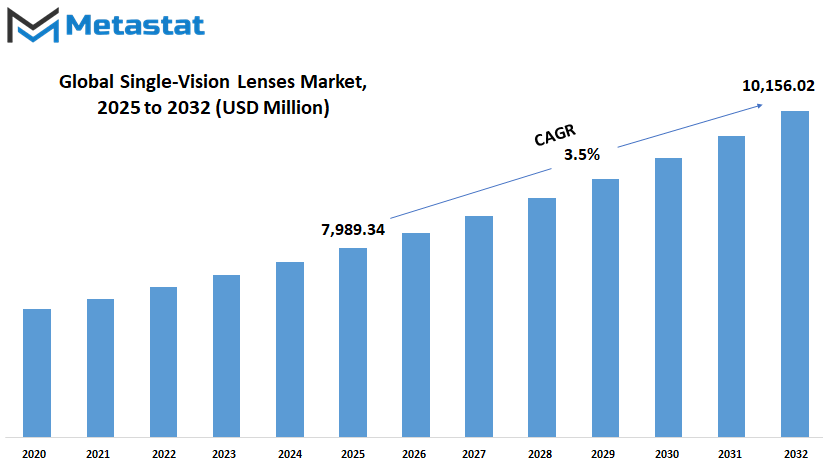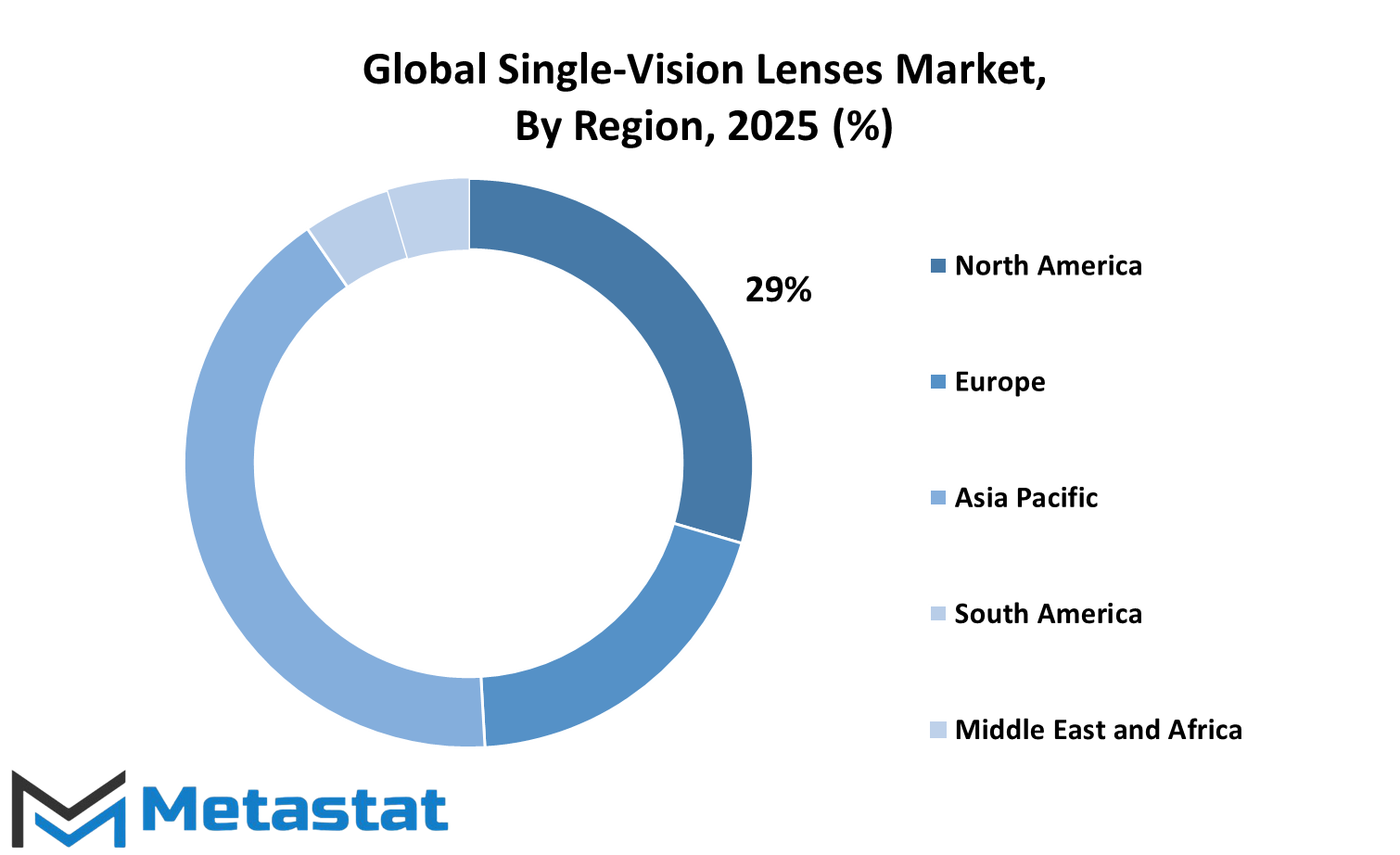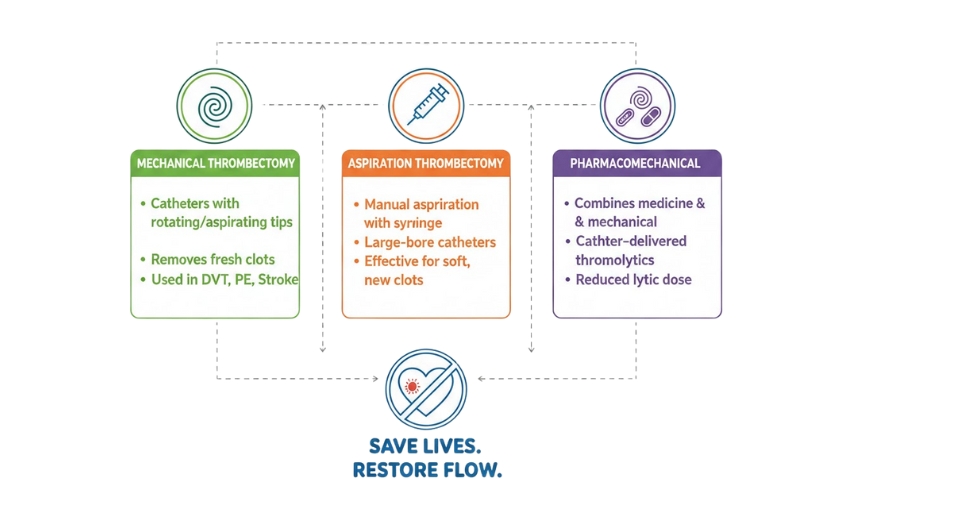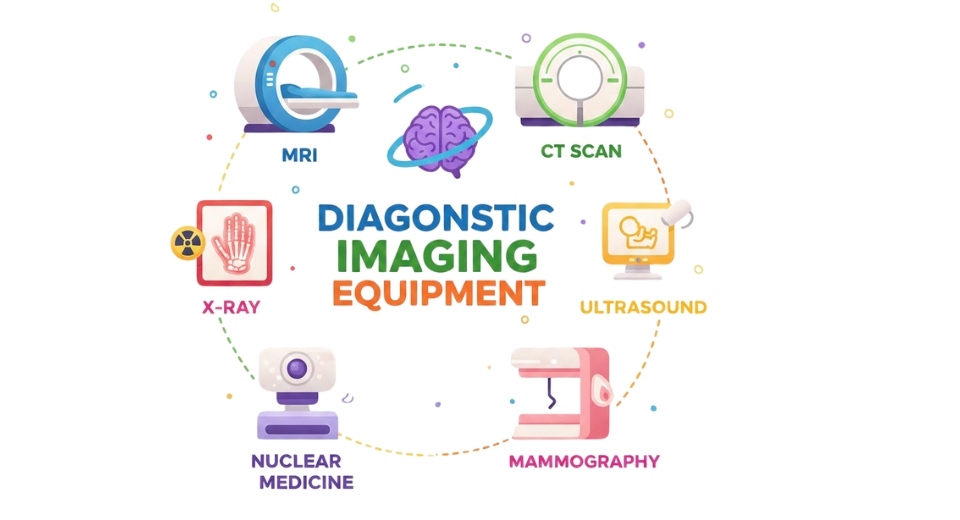MARKET OVERVIEW
The Global Single-Vision Lenses market and its industry is concerned with the manufacturing, distribution, and application of lenses intended to correct a single field of vision. These lenses are used by people with myopia or hyperopia, where the prescription strength is constant throughout the entire surface. Manufacturers of optical products, retailers, and healthcare professionals develop and perfect these products to ensure they meet the needs of consumers and technological changes.
This market spans numerous regions, offering corrective eyewear to a mass population. Because vision-related problems continue to haunt people all around the world, single-vision lenses remain high in demand for the optical business. From prescription glasses to high-performance coatings enhancing durability and visibility, these products cater to every consumer preference.
The market includes plastic, polycarbonate, and high-index types, all offering specific applications: lightweight construction, impact resistance, and so on. Innovations in lens manufacturing and digital customization are shaping the future landscape of this industry. Advanced technologies will enable precise tailoring of lenses to individual prescriptions, improving comfort and visual accuracy. Blue-light filtering solutions and anti-reflective coatings will be more prominent as consumers become more aware of digital eye strain and prolonged screen exposure.
Distribution channels for these lenses are different and affect the way one purchases. Online and offline channels will be equally influential. E-commerce platforms will continue to open up greater accessibility, so that consumers can look at an array of products with virtual try-on features and detailed specifications. Optical stores and clinics will still play a vital role, providing professional consultations and personalized fittings to ensure user satisfaction.
While affordability will remain a key criterion, premium lens offerings will focus on those interested in advanced optical solutions. Manufacturers will be forced to perfect their production techniques by the demand for lightweight, rugged, and high-performance lenses. Sustainable practices will also become an important aspect and lead to eco-friendly materials and recyclable packaging that will address global environmental concerns.
The single-vision lenses market in the Global Single-Vision Lenses market will experience changes due to technological integration and customer preferences. Gradually, digital devices are becoming part of the people's life, and the lens manufacturers will adhere to emerging requirements. Solutions that reduce the visual fatigue and provide good optical performance will be introduced, that will solidify the importance of these lenses in the optical industry and continue to remain relevant in the future.
Global Single-Vision Lenses market is estimated to reach $10,156.02 Million by 2032; growing at a CAGR of 3.5% from 2025 to 2032.

GROWTH FACTORS
The Global Single-Vision Lenses market will observe immense growth in the following years because of the different factors that determine consumer preference and technological advancement. One key factor is the demand for sustainable, energy-efficient materials in construction projects. The world is gradually shifting towards more eco-friendly solutions while industries have shifted their focus towards materials with the least environmental footprint.
It stretches even to eyewear, with the consumer and the manufacturer in this industry working together to optimize efficiency without necessarily losing sustainability. Another prominent driver of the growth of this market is prefabrication-approach implementation. This not only reduces the construction time but also the associated cost.
The need for speed and efficiency in multiple industries, which even includes manufacturing of eyeglasses, nudges companies into more innovative techniques of production. Reduced production time will improve efficiency in businesses while satisfying the increasing demand for single-vision lenses. Moreover, rapid urbanization and infrastructure development, especially in emerging economies, will give a boost to the market for lightweight and modular solutions.
With the expansion of cities and advancements in technology, the demand for optical products that can cater to changing lifestyles is expected to increase. However, some challenges may slow down the expansion of the market. Many of the costs are due to material and fabrication. Advanced manufacturing techniques are very expensive for material and fabrication.
Long-term: energy-efficient solutions, modular production methods, may be preferred, but it does require a little investment at the initial stage, so when it comes to new investment or some new companies in those particular regions who are worrying about affordability, here it comes. Skilled labor with highly specialized expert can also limit the manufacturing process.
Specialized knowledge is required in integrating modern techniques of production; thus, complete utilization of innovation without proper education and experience may not be actualized. Indeed, the opportunities will be extensive, as every industry will always welcome innovation as they strive towards change. Growth in demand to achieve better solutions of optics by the consumers through advancement in product performance will therefore continue.
The competitive advantage for such companies would come from new product introductions, which combine affordability, sustainability, and efficiency. Industry players in collaboration with education institutions may alleviate labor shortages through training programs to equip workers with the needed skills. With further advancements in material science and production technology, the Global Single-Vision Lenses market is expected to grow steadily.
Companies that can adjust to changing market dynamics and invest in forward-thinking solutions will be well-positioned for success. With growing awareness of sustainability and efficiency, the market will continue to evolve, offering new opportunities for both manufacturers and consumers in the coming years.
MARKET SEGMENTATION
By Material
The single-vision lenses market is currently growing fast in terms of sales due to the rapidly increasing percentage of people suffering from myopia and hyperopia. These lenses correct vision at only one distance and are thus an indispensable aid for most individuals who want better vision. By looking ahead into the future, we may observe various other raw materials used to make these lenses, namely glass, polycarbonate plastic, among others, which would affect market trends as well as consumer demand.
Historically, glass lenses were more of the standard since they are more optically clear and resistant to scratches. However, it was slightly heavy and fragile that makes people to abandon them. In the next few years, the preference of glass lenses would still benefit from optical quality as well as durability. In any case, glass lenses are still likely to have to face low market share because of the said disadvantages.
Polycarbonate lenses have gained currency because of its light weight along with high resistance to impact. These qualities prove particularly attractive in the case of active individuals or children. For consumers, whose safety and comfort are becoming top priorities, their demand for the polycarbonate lenses is destined to increase even further. Better manufacturing processes should also improve further the optical qualities of these lenses, making their appeal wider still.
Plastic lenses, often made from CR-39 material, offer a good balance between weight, cost, and optical clarity. They are lighter than glass lenses and more affordable than polycarbonate options. Looking ahead, plastic lenses are expected to maintain a strong presence in the market, especially among cost-conscious consumers. Innovations in plastic lens technology may lead to improved scratch resistance and thinner designs, increasing their attractiveness.
There are, however, many more specific options on the horizon. High-index lenses, for instance, provide the possibility for thinner and lighter designs even with strong prescriptions. With aesthetic considerations and comfort increasingly shaping consumer preferences, the use of high-index and other advanced material lenses is expected to rise.
The future of single-vision lenses is in the changing demand for lens material. Even though glass lenses are expected to hold some niche markets, polycarbonate and plastic lenses will become the market in high demand as a result of the beneficial properties. Further diversity of choice by the consumer in the needs and preferences for correction of vision is further ensured through the introduction of new materials and technologies.
By Type
The single-vision lenses market globally is growing rapidly. This growth can be attributed to the increased cases of vision impairment, including myopia and hyperopia. This growth trend can be primarily associated with the growing number of people who need corrective vision. Long hours spent staring at screens and an aging global population contribute to this growth. Single-vision lenses are used to correct vision at a single distance. In many cases, this provides a simple solution.
The market offers various types of lens to cater to the different needs that are required. High-index single-vision lenses are thinner and lighter in weight and can accommodate stronger prescriptions, suitable for individuals with a stronger prescription. Plastic single-vision lenses are made to be economical and also lightweight for everyday use. Polycarbonate single-vision lenses are highly durable and are shock resistant. This makes them suitable for kids and individual people who engage in active lifestyles.
There will still be a lot of changes in the market ahead because of advancements in lens technology and materials. Innovations meant for improved visual comfort and getting over certain vision problems are being expected. With growing awareness around eye health and increased access to vision care across the globe, demand for single-vision lenses will likely continue to be robust.
The global market of single-vision lenses has remained on an upbeat track through constant technological advances, along with growing demands in corrective vision needs. A plethora of lens options have made available an assortment to pick and match any visual demand coupled with specific preferences for living lifestyles.
By Age Group
The global market for single-vision lenses is growing at a significant rate, with the rising prevalence of vision impairments among different age groups. These lenses are used to correct vision at a single distance and are thus essential in correcting myopia, hyperopia, and astigmatism. In the future, we should look at how different age demographics contribute to this market's expansion.
The demand for single-vision lenses is increasing for people under the age of 18. It is attributed mainly to increased use of digital gadgets and increased exposure to screens for long periods. This increases myopia among school-going children. Early diagnosis is essential for young people, in order to achieve academic success, as well as for proper developmental growth. Parents and guardians are becoming more conscious of the importance of eye health, which has led to an increased adoption of corrective lenses for younger individuals.
The age group between 18 and 40 years is a significant portion of the single-vision lenses market. Adults in this bracket often require vision correction due to lifestyle factors, including prolonged exposure to screens and the demands of modern work environments. Single vision lenses are the most preferred type of lens for controlling vision problems during these years in life because they are convenient and efficient. As this segment of the population will continue to pursue activities that put strain on their eyesight, demand for reliable correction of vision will continue.
Individuals over 40 years of age also form a significant market share. In the aging population, presbyopia is one common condition that tends to develop requiring corrective measures. Though multifocals are possible, most use single vision to read or for driving. Since the world population is aging, the demand will be sustained by these lenses to maintain quality living.
To an extent, for the future: single-vision lenses will probably gain popularity more across all different age groups following improvements in technological developments of their lenses. Solutions for clearer and lighter lenses may appeal to this broader market spectrum. Furthermore, more people focusing on eye care and regular inspections of their visual abilities will only contribute to improving detection and curing of vision failures.
The global single-vision lenses market continues to expand and is represented in every age category, each presenting distinct needs and opportunities. Thus, the industry will be able to best meet the changing needs of individuals to have perfect correction at various ages throughout life by focusing on tailored solutions and embracing technological advances.
By Application
The global market of single-vision lenses is surging due to the growing nature of vision diseases like myopia, hyperopia, and astigmatism among people. The condition myopia is also known as nearsightedness. This is growing to be a worldwide problem largely due to factors such as increased screen time and prolonged near-work activities. Single-vision lenses focus light precisely on the retina, which improves distance vision. In like manner, hyperopia is referred to as farsightedness, and astigmatism is an irregularly shaped cornea that leads to blurriness of images, both of which are well managed with these lenses.
Technological advancements are also responsible for market growth. Digital lens designs and freeform technology have resulted in the creation of lenses that provide superior visual acuity and comfort. For example, 360° visual clarity lenses provide complete focus at all angles, enhancing the accuracy of vision for most daily tasks.
The market will continue to grow as awareness about eye health improves and access to eye care increases across the world. The increased demand for vision correction solutions along with the development of lens technology in the research and development front holds a great promise for the single-vision lenses market.
|
Forecast Period |
2025-2032 |
|
Market Size in 2025 |
$7,989.34 million |
|
Market Size by 2032 |
$10,156.02 Million |
|
Growth Rate from 2024 to 2031 |
3.5% |
|
Base Year |
2024 |
|
Regions Covered |
North America, Europe, Asia-Pacific, South America, Middle East & Africa |
REGIONAL ANALYSIS
The market for single vision lenses globally is expected to grow very rapidly, with growth brought about by improvements in optical technology and growing awareness of vision health. Much of this development comes from different regions around the world, each with its unique dynamics influencing demand and innovation.
North America remains a leader, driven primarily by the United States, Canada, and Mexico. Established optical brands and an aging population are driving the demand for single-vision lenses. Advances in eye care solutions and increased digital screen usage are also driving the market.
Manufacturers in this region will focus on personalized vision correction, investing heavily in research and development to introduce lenses with enhanced durability and improved optical precision. Europe is also a significant contributor to this industry, with the UK, Germany, France, and Italy being major contributors.
The region has a good healthcare infrastructure and high awareness about the importance of eye health. Consumers in these countries are more inclined toward high-quality lenses that offer better clarity and comfort. Furthermore, government schemes related to eye care and improved lens coating technologies will further propel the market. The growth of anti-reflective and blue-light-blocking lenses will shape the market in the years ahead.
The Asia-Pacific region is experiencing an accelerated growth rate, with key markets being developed in India, China, Japan, and South Korea. The rising middle-class population, urbanization, and increased screen time are causing a surge in demand for vision correction solutions.
China and India have a large consumer base, making them attractive markets for manufacturers. In response, companies are focusing on affordability without compromising quality, ensuring that a wider audience can access advanced single-vision lenses. Other growth factors in the market will be investment in healthcare infrastructure and online retail expansion.
Apart from North America, single-vision lenses are enjoying steady demand from South America with Brazil and Argentina. Although they are still significantly behind the countries of North America and Europe as far as development is concerned, improving economic circumstances and growing disposal income have goaded people here to spend much more on upgrading their eye-care solutions. Moreover, the sales of imported lenses and a developed retail distribution chain will also strengthen the market expansion in the long run.
The Middle East & Africa region, including GCC countries, Egypt, and South Africa, will offer growth opportunities as awareness of vision care increases. Improving healthcare facilities and a growing number of optical stores are making single-vision lenses more accessible. In addition, rising urbanization and lifestyle changes are expected to drive demand, with consumers seeking better eye protection from environmental factors such as strong sunlight and dust. Looking ahead, the Global Single-Vision Lenses market will shape up with high technology and with the changing preferences among customers.
Companies are expected to make lightweight, sturdy, and more customized lenses in the future as requirements keep varying. The constant rate of digitalization in the field of eye care ranging from online prescriptions to AI-based customization is also expected to contribute to a lot of the transformation in the market. As vision health is gaining importance around the world, the market will expand with a new opportunity to innovate and provide access.

COMPETITIVE PLAYERS
The increasing cases of myopia and hyperopia have caused the global single-vision lenses market to expand rapidly. This growth is mainly attributed to the increased number of people who require correction of their vision, especially as a result of lifestyle changes with more screen time. This has increased demand for single-vision lenses that are used for correction at one distance, whether for near or far-sightedness.
There are several major players in the market that are changing its course. EssilorLuxottica is a result of the merger between Essilor and Luxottica. The company is the largest player in the eyewear industry, and it has been an innovation leader in smart eyewear developed in partnership with technology companies. For example, their collaboration with Meta, formerly Facebook, has resulted in the development of high-tech eyewear that embeds functionalities like cameras and AI assistants, positioning them as alternative devices to the smartphone.
Other key players in the market are the Hoya Corporation, with its high-quality optical products, and Carl Zeiss AG, famous for precision optics. Nikon Corporation also contributes to the company's development through various applications of imaging technology to produce the best lenses. Rodenstock GmbH and Shamir Optical Industry Ltd. are famous for innovative approaches in lens technology to cope with the varied needs of consumers.
Looking into the future, it seems that the market is even brighter, with much scope for further development since companies do not stop at an investment in R&D. Today, the idea is to work on creating not only correcting lenses but also health-enhancing lenses which can protect from dangers of dangerous blue light emitted by digital devices. Such a trend will be promptly relevant in this world where there is more screen-hugging and it is prevalent, thereby pleasing consumers.
In addition, eyewear embedding digital technology in it is most likely to redraw the user's experience. Already, smart contact lenses with their augmented reality features are on cards, promising them to overlay their digital information regarding the user directly over the user's field of view, while enriching every personal and professional application.
In conclusion, the global market for single-vision lenses is on an uptrend, boosted by a synergistic combination of increasing demand for vision correction and technological innovations. As leading companies continue to push the boundaries of what's possible in eyewear, consumers can look forward to products that improve vision but, more importantly, enhance overall quality of life through added functionalities.
Single-Vision Lenses Market Key Segments:
By Material
- Glass
- Polycarbonate
- Plastic
- Others
By Type
- High-index Single Vision Lenses
- Plastic Single Vision Lenses
- Polycarbonate Single Vision Lenses
By Age Group
- < 18 Years
- >= 18 Years & < 40 Years
- >= 40 Years
By Application
- Hyperopia (Farsightedness)
- Myopia (Nearsightedness)
- Astigmatism
- Other
Key Global Single-Vision Lenses Industry Players
- Essilor International S.A.
- Bod Lenses
- Hoya Corporation
- ZEISS International
- CHEMIGLAS CORP.
- GKB OPHTHALMICS LTD.
- Nikon Corporation
- Rhein Vision
- SEIKO OPTICAL PRODUCTS CO., LTD.
- VSP Global
- Rodenstock GmbH
- SEED Co., Ltd.
- Shamir Ltd.
- Shanghai Conant Optical Co., Ltd.
- TOG USA
WHAT REPORT PROVIDES
- Full in-depth analysis of the parent Industry
- Important changes in market and its dynamics
- Segmentation details of the market
- Former, on-going, and projected market analysis in terms of volume and value
- Assessment of niche industry developments
- Market share analysis
- Key strategies of major players
- Emerging segments and regional growth potential








 US: +1 3023308252
US: +1 3023308252






